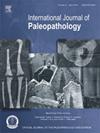Multi-level spondylolysis at Egiin Gol: A case from Xiongnu period Mongolia
IF 1.5
3区 地球科学
Q3 PALEONTOLOGY
引用次数: 0
Abstract
Objective
This paper presents and discusses the aetiology of an extreme case of multi-level spondylolysis with unique presentation.
Materials
The affected individual is an adult male from Xiongnu period (209 BCE to 93 CE) Egiin Gol, northern Mongolia.
Methods
Analyses were limited to macroscopic and non-invasive methods.
Results
Seven complete spondylolytic clefts were documented on four vertebrae between T12 and L4, with only one located on L4, where most cases of spondylolysis occur, and four defects had atypical morphology. Evidence of spondylolisthesis was also observed.
Conclusions
Congenital susceptibility to spondylolysis, combined with a physically demanding lifestyle, likely account for the condition’s unusual manifestation.
Significance
The significance of this case its severity (one of the most extreme documented from archaeological contexts) and unusual presentation (location of the clefts and their atypical morphology).
Limitations
Only a small sample (< 30) of Xiongnu period human remains were available for comparison.
Suggestions for further research
Interpretations from this case study would benefit from a more extensive analysis of spondylolysis, biomechanical stress, and acute trauma on the nomadic pastoral populations of northern Mongolia, including those pre-dating and post-dating the Xiongnu.
蒙古匈奴时期额济纳河多层次峡部裂1例
目的介绍并讨论一例具有独特表现的多椎体峡裂的极端病例的病因。研究对象为蒙古北部埃金戈尔匈奴时期(公元前209年至公元93年)的一名成年男性。方法采用宏观和非侵入性方法进行分析。结果在T12 ~ L4之间的4个椎体上记录了7例完全性峡裂,其中仅1例位于L4,大部分发生峡裂,4例缺损形态不典型。还观察到椎体滑脱的证据。结论先天性峡部裂易感性,加上高体力要求的生活方式,可能是导致该疾病不寻常表现的原因。该病例的重要性在于其严重程度(考古文献记载的最极端之一)和不寻常的表现(裂缝的位置及其非典型形态)。局限性:只有一小部分匈奴时期的人类遗骸样本(<; 30)可供比较。对进一步研究的建议和本案例研究的解释将受益于对蒙古北部游牧民族的脊柱裂、生物力学应力和急性创伤的更广泛的分析,包括那些追溯到匈奴之前和之后的人。
本文章由计算机程序翻译,如有差异,请以英文原文为准。
求助全文
约1分钟内获得全文
求助全文
来源期刊

International Journal of Paleopathology
PALEONTOLOGY-PATHOLOGY
CiteScore
2.90
自引率
25.00%
发文量
43
期刊介绍:
Paleopathology is the study and application of methods and techniques for investigating diseases and related conditions from skeletal and soft tissue remains. The International Journal of Paleopathology (IJPP) will publish original and significant articles on human and animal (including hominids) disease, based upon the study of physical remains, including osseous, dental, and preserved soft tissues at a range of methodological levels, from direct observation to molecular, chemical, histological and radiographic analysis. Discussion of ways in which these methods can be applied to the reconstruction of health, disease and life histories in the past is central to the discipline, so the journal would also encourage papers covering interpretive and theoretical issues, and those that place the study of disease at the centre of a bioarchaeological or biocultural approach. Papers dealing with historical evidence relating to disease in the past (rather than history of medicine) will also be published. The journal will also accept significant studies that applied previously developed techniques to new materials, setting the research in the context of current debates on past human and animal health.
 求助内容:
求助内容: 应助结果提醒方式:
应助结果提醒方式:


